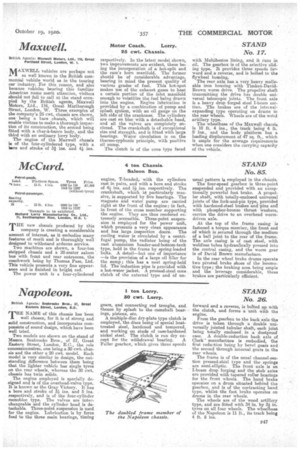McCurd.
Page 55

If you've noticed an error in this article please click here to report it so we can fix it.
4 ton Chassis. Saloon Bus.
STAND No. 85.
THE new chassis produced by this I company is creating a considerable amount of interest, as it embodies Many features of merit and is thoroughly well designed to withstand arduous service.
Two machines are shown, a four-ton stripped chassis and a 28-seater saloon' hurl with front and rear entrances, the coachwork being by Thomas Pass, Ltd. This vehicle presents a very fine appearance and is finiahed in bright red. The power unit is a four-cylinclered
engine, T-headeds with the cylinders cast in pairs, and with a bore and stroke of 4; ins. and 51 ins, respectively. The crankshaft, which is particularly massive, is supported by five bearings. The magneto and water pump are carried right at the front of the engine; in fact, in front of the cross member supporting the engine. They are thus rendered extremely accessible. Three-point suspension is employed for the power unit, which presents a very clean appearance and has large inspection doors. The cooling water is circulated by a centrifugal pump, the radiator being of the cast aluminium header-and-bottom-tank type, hold in the frame by spring-loaded bolts. A detail—but one of importance —is the provision of a large oil filler for the sump ; this has a neat spring-held lid. The induction pipe is provided with a hot-waiter jacket. A pressed-steel cone clutch of the external type and of un
usual pattern is employed in the chassis. The four-speed gearbox is three-point suspended and provided with an exceptionally powerful foot brake. A propeller shaft, with totally-enclosed universal joints of the fork-and-pin type, provided with hardened-steel bushes and pins and with phosphor-bronze thrust washers, carries the drive to an overhead wormdriven axle.
At the top of the _frame casing is fastened a torque member, the front end of which is secured through the medium of a ball joint to the rear of the frame. The axle casing is of cast steel, with weldless tubes hydraulically pressed into the central casing, and the worm gear is of David Brown manufacture.
In the rear wheel brake drums operate two pivoted brake shoes of the locomotive type; the braking area being ample and the leverage considerable, these brakes are particularly efficient.












































































